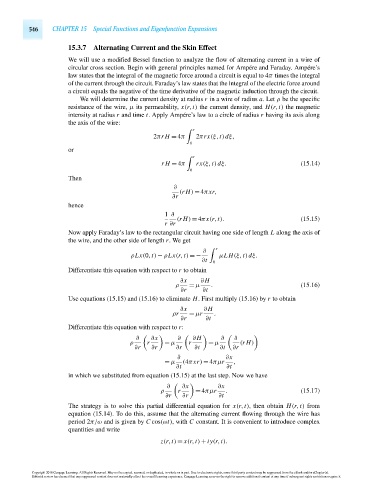Page 566 - Advanced_Engineering_Mathematics o'neil
P. 566
546 CHAPTER 15 Special Functions and Eigenfunction Expansions
15.3.7 Alternating Current and the Skin Effect
We will use a modified Bessel function to analyze the flow of alternating current in a wire of
circular cross section. Begin with general principles named for Ampére and Faraday. Ampére’s
law states that the integral of the magnetic force around a circuit is equal to 4π times the integral
of the current through the circuit. Faraday’s law states that the integral of the electric force around
a circuit equals the negative of the time derivative of the magnetic induction through the circuit.
We will determine the current density at radius r in a wire of radius a.Let ρ be the specific
resistance of the wire, μ its permeability, x(r,t) the current density, and H(r,t) the magnetic
intensity at radius r and time t. Apply Ampére’s law to a circle of radius r having its axis along
the axis of the wire:
r
2πrH = 4π 2πrx(ξ,t)dξ,
0
or
r
rH = 4π rx(ξ,t)dξ. (15.14)
0
Then
∂
(rH) = 4πxr,
∂r
hence
1 ∂
(rH) = 4πx(r,t). (15.15)
r ∂r
Now apply Faraday’s law to the rectangular circuit having one side of length L along the axis of
the wire, and the other side of length r. We get
∂ r
ρLx(0,t) − ρLx(r,t) =− μLH(ξ,t)dξ.
∂t 0
Differentiate this equation with respect to r to obtain
∂x ∂ H
ρ = μ . (15.16)
∂r ∂t
Use equations (15.15) and (15.16) to eliminate H. First multiply (15.16) by r to obtain
∂x ∂ H
ρr = μr .
∂r ∂t
Differentiate this equation with respect to r:
∂ ∂x ∂ ∂ H ∂ ∂
ρ r = μ r = μ (rH)
∂r ∂r ∂r ∂t ∂t ∂r
∂ ∂x
= μ (4πxr) = 4πμr ,
∂t ∂t
in which we substituted from equation (15.15) at the last step. Now we have
∂ ∂x ∂x
ρ r = 4πμr . (15.17)
∂r ∂r ∂t
The strategy is to solve this partial differential equation for x(r,t), then obtain H(r,t) from
equation (15.14). To do this, assume that the alternating current flowing through the wire has
period 2π/ω and is given by C cos(ωt), with C constant. It is convenient to introduce complex
quantities and write
z(r,t) = x(r,t) + iy(r,t).
Copyright 2010 Cengage Learning. All Rights Reserved. May not be copied, scanned, or duplicated, in whole or in part. Due to electronic rights, some third party content may be suppressed from the eBook and/or eChapter(s).
Editorial review has deemed that any suppressed content does not materially affect the overall learning experience. Cengage Learning reserves the right to remove additional content at any time if subsequent rights restrictions require it.
October 14, 2010 15:20 THM/NEIL Page-546 27410_15_ch15_p505-562

